Albanian Riviera

The Albanian Riviera, a stretch of land from the Llogara Pass to Ksamil, is one of the most beautiful places to visit in Europe. With its pristine beaches, ancient hamlets, and gorgeous vistas, this region of Albania is a must-see destination along the Balkan trail. The Albanian Riviera also popularly known as Bregu is a coastline along the Northeastern Ionian Sea in the Mediterranean Sea encompassing the disctrics of Sarande and Vlore in Southewestern Albania. It forms an important section of the Albania Ionian Sea Coast dotted with the villages of Palase, Dhermi, Vuno, Himara, Qeparo, Borsh, Piqeras, Lukove and Sarande.
If you love to spend your summer holidays in total relaxation, surrounded by olive groves and crystal clear waters, well, the Albanian Riviera is the right place for you. It offers travelers the best beaches in the country, and some of the best in the Balkans, for half the price of other neighbouring countries like Italy, Greece, Montenegro, and Croatia. Despite locals and travelers frequenting the more famous beaches of the area, like Dhërmi Beach, Borsh Beach, and Ksamil, the Albanian Riviera has plenty of hidden bays that are just as pleasant. Since they are hidden, they are not crowded, not even in the peak of the season. Don’t miss the chance to relax at Drymades, Gjipë, or Jalë, three of the most beautiful beaches of the Mediterranean Sea.
The best way to admire these fabulous views is to reach the hilltop villages by sunset. With its major nightlife, ecotourist, and elite retreat destination, Albania’s coastline offers visitors views that seem only possible in dreams.
Bunk’Art in Tirana
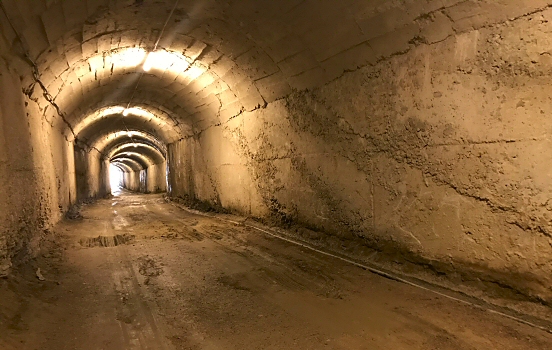
This fantastic conversion from a massive Cold War bunker on the outskirts of Tirana into a history and contemporary art museum, is Albania’s most exciting new sight and easily a Tirana highlight. With almost 3000 sq metres of space underground spread over several floors, the bunker was built for Albania’s political elite in the 1970s and remained a secret for much of its existence. Now it hosts exhibits that combine the modern history of Albania with pieces of contemporary art.
Location
- Rruga Fadil Deliu Tirana
Schedule
- Monday: Closed
- Tuesday: Closed
- Wednesday: 9am – 4pm
- Thursday: 9am – 4pm
- Friday: 9am – 4pm
- Saturday: 9am – 4pm
Price
- 500 ALL
UNESCO town of Gjirokastra

Gjirokastra, also known as the City of Stone, is part of the UNESCO wold heritage list and is one of the most attractive tourist sites of the county.
Perched on the eastern side of the Wide Mountain (Mali I Gjere), the city began as a fourth century castle, which is today the greatest castle in the whole country and the most important structure of the city. Inside the fortress is the Museum of Weapons, where weapons of different periods up until the Second Work War are displayed.
The main characteristic of Gjirokastra is the intensive use of stone in building the houses, which look like small fortresses, the streets of cobblestone, which all lead to Bazaar.
The town of Gjirokastra is also known for its culinary art; we can mention special dishes like pasha qofte, shapkat, oshaf with dried figs (a dessert with sheep`s milk, sugar and dried figs), etc.
In Gjirokastra you can visit interesting sites, part of the cultural heritage as well as natural wonders.
Berat The City Of A Thousands Windows

This 2,413 years-old city, the pride of Albanian architecture which is under the protection of UNESCO, is located 120km from Tirana. The city forms a wonderful combination of eastern and western cultures, costumes, traditions and outlook.
The sight of the white facades and their many windows has earned Berat the nicknames ‘City of Thousand Windows’ and ‘The White City’.
These houses mostly date back to the time when Berat was an Ottoman city, but the city actually has a history going back 2.500 years. You’ll find traces that go back to the Illyrians, but also Byzantine religious monuments, Ottoman houses and mosques and a medieval fortress. It had all we love about a small city. No wonder it was already declared a museum city in 1961 by the Albanian government and Unesco World Heritage in 2008.
Berat is a treasure-trove of Albanian history, culture and a testament to the country’s tradition of religious harmony.
The old city of Kruja
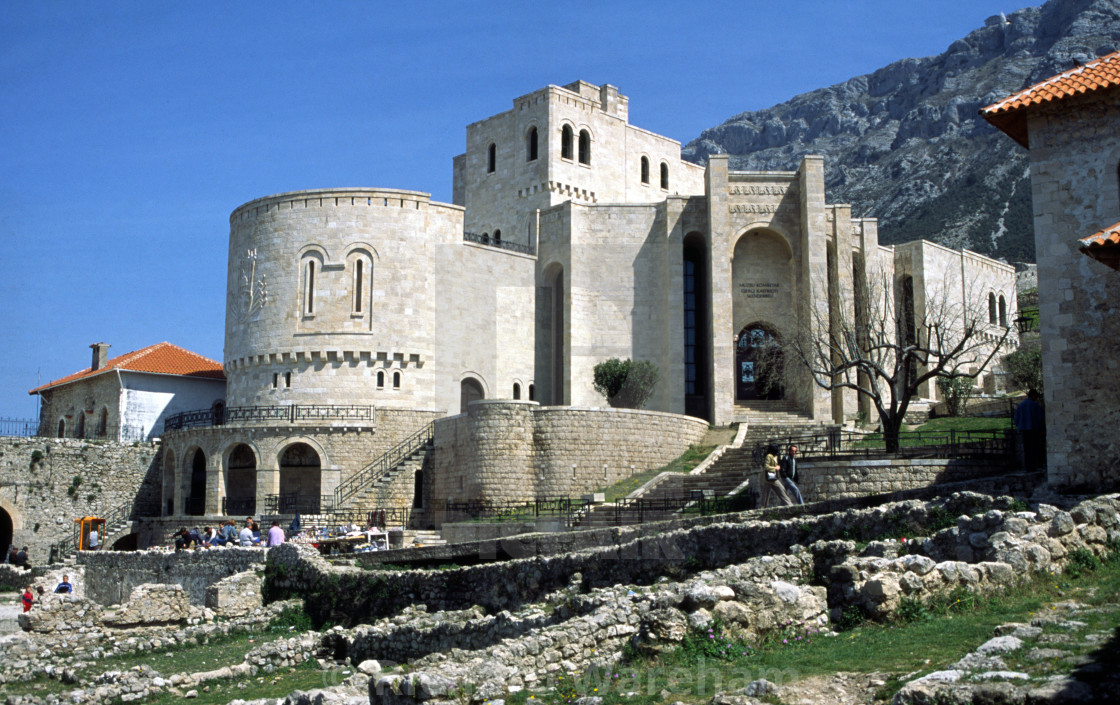
Kruja, also knows as the city of Skanderbeg, is a place rich in history. The name and the importance of the city are closely related to the 25 years of activity of the national hero, Skanderbeg, who in the fifteenth century made Kruja a bastion of uncompromising resistance against the Ottoman. The Gjergj Kastrioti Skanderbeg Museum is situated inside the castle walls, which date back to the fifth and sixth centuries A.D.
The museum itself was inaugurated in 1981. Within the walls of the castle are also the Ethnographic Museum and the Dollma Tekke. Near the castle’s entrance is a traditional market, which dates back to the period of Skanderbeg. Here, tourists can find Albanian craft products such as embroidered items, carpeting, silver objects, copper, alabaster, filigree, traditional clothing, antiques at the traditional Old Baazar of Kruja .
Port Palermo Castel

Porto Palermo Castle is a castle near Himara in southern Albania with an intriguing history. The Porto Palermo fort is situated in the closed bay of Porto Palermo, a few kilometers south of Himarë, and makes nearly an island that is connected to the mainland by a narrow strip of land.
The well preserved castle is commonly, but wrongly, asserted, by guide books and the local tourist guides, to have been built in early 19th century by Ali Pasha of Tepelena. It looks to have been built prior to the evolution of the star fort design. Most probably it was built by the Venetians as it could be relieved by sea and it has the same triangular plan with round towers found in the Venetian fort at Butrint.
The fort served as former Soviet submarine base during the communist regime in Albania, and nowadays it’s semi abandoned tunnel and barrack attract attention of visitors, as well as the stronghold walls and gates.
Location
• Porto Palermo
Schedule
• Every day: 9am – 7pm
Price
• 100 ALL
Saranda city

Saranda is one of most charming towns of the Albanian Riviera. It is a top choice destination that every traveler should include in his itinerary and will not disappoint you. During the summer months it seems like half Tirana relocates here to enjoy the busy beach and busier nightlife along its crowd-filled seaside promenade. What was once a sleepy fishing village is now a thriving city, and while Saranda has lost much of its charm in the past two decades, it has retained much of its charisma.
Saranda is a great base for exploring the beaches around such as Pulebardhat , Pasqyrat , Manastiri beaches ect., or going to Ksamil beaches and Butrint UNESCO World Heritage Site. Saranda is not just home to extraordinary beaches but has a long and ancient history too. The town takes its name from the monastery of forty saints built on a hill behind the bay in the 15th century. Saranda is well connected with cruisers that come from all over the world and Corfu (the Greek town in front of Saranda). During summer is mostly full of tourists from Nordic or Eastern Europe countries for its climate, food and beauty .
National Park of Theth

On the date of 11.21.1966, the cabinet credited the area of Theth, with a surface of 2630 ha: from which 1680 ha are forest along the sea-line and the other part is gas-plot and grust. It is now declared a “National Park” and is overseen by the D.SH.P, district of Shkodra.
The “National Park of Theth” lies into the center of the Albanians Alps, between the block “Bjeshket te Nëmuna” on the west, and the block of Jezerca on the east. Thethi is a tourist – alpinist region and it is the most important one north of the country. It is only 70 km away from the city of Shkodra. It is a part of the commune Shalë within the region of Dukagjin.
Through the Thethi National Park runs the Theth River with a plentiful supply of mountain trout. The Grunas waterfall is particularly worth visiting. The mountain slopes are very steep due to changes in temperature and snow precipitation that are present in most part of the year, which helped in the formation of various jags.
Thethi is a tourist – climbing, hiking and alpinist region and the most important tourist center of the northern Albania. Within the territory of Theth National Park and its surroundings there are about 170 caves and semi caves, of which 10 caves are of international category. There are simple accommodation facilities in the Theth National Park which provide tourist services to visitors, excellent organic homemade food and decent accommodation in their houses, in the gorgeous and remote areas of the Theth National Park.
Karaburun Peninsula

The Karaburun Peninsula is a peninsula of the Mediterranean Sea located in Southern and Southeastern Europe, which is almost completely surrounded by both the Adriatic Sea to the north and the Ionian Sea to the south. A finger of land jutting into the Adriatic Sea, Albania’s Karaburun Peninsula is nothing if not rocky.
The Karaburun peninsula is completely undeveloped and offers a fantastic hiking opportunity in one of the loneliest parts of the Albanian Riviera. A part of the mountains is designated as a national park which is rich in wildlife, including deer, foxes, wild boars and even wolves. The area has many unspoilt pebble beaches and several fascinating sea caves.
Llogara Pass
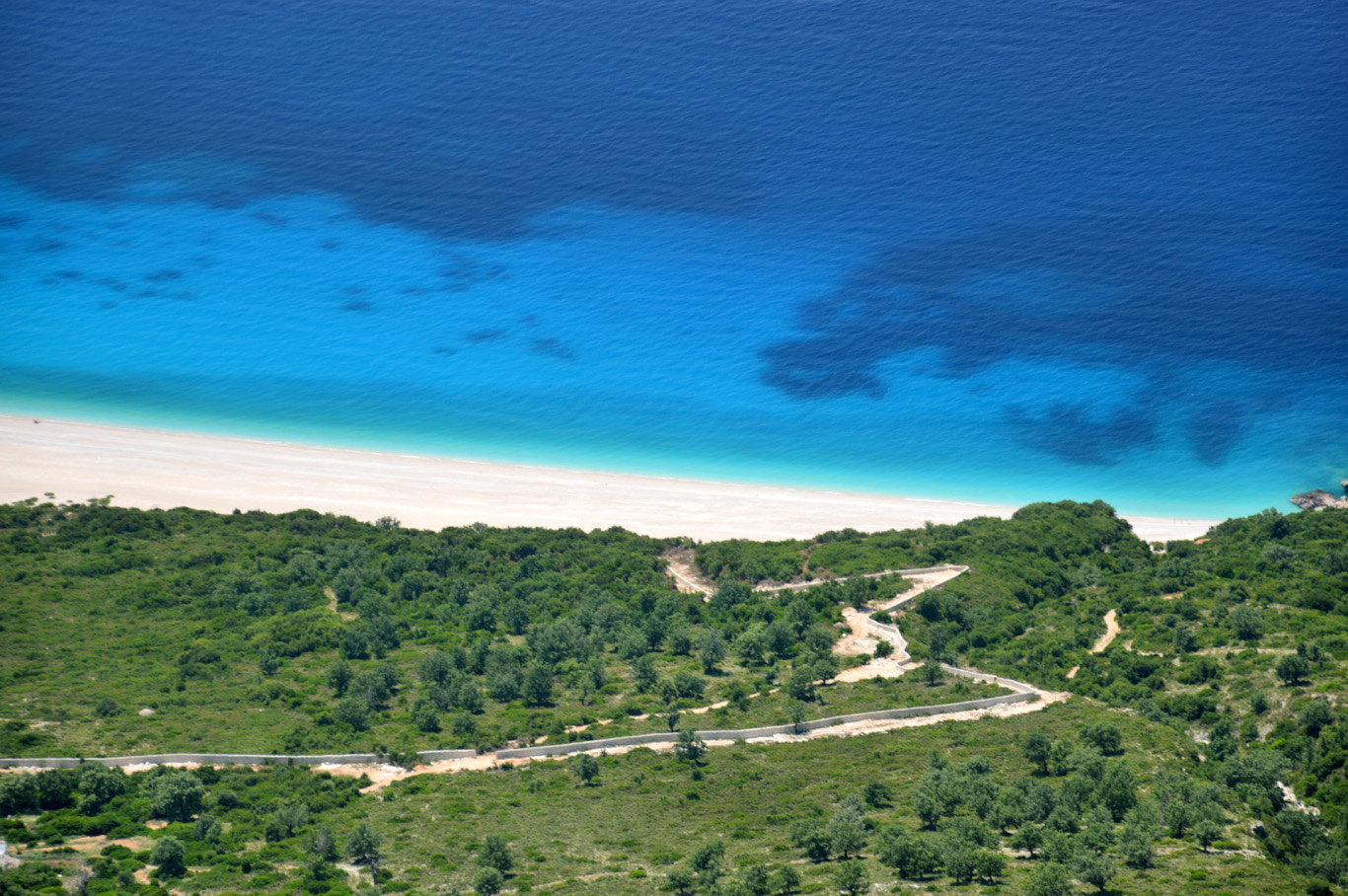
Llogara Pass is a high mountain pass at an elevation of 1.043m (3,422 ft) above the sea level, connecting the Dukat Valley in the north with the Albanian Riviera on the southern side. This is the highest point on the main coastal road between Vlore and Sarande. The pass is traversed by SH-8 road. It’s one of the best coastal drives in the world.
The Llogara Pass divides the mountains into a western and an eastern range. The western chain are also known as Acroceraunian Mountains. In some places the mountains fall directly into the sea. The Mountains have been remarked upon already by ancient authors such as Ptolemy, Strabo and Pausanias.
Looking down from the Pass to the south along the coast you can admire the white beaches of Ionian sea and the village of Dhermi. This part of the country is renowned for the best climate in the whole Albania. The average January temperature is up to 10 degrees, and the average July temperature equals to 25 degrees. The region has about 300 sunny days a year.
The drive is definitely worth it. Don’t forget your camera! Llogara Pass serves as a panoramic venue to exploring the Riviera from above and touching the clouds at the same time. The experience of using this road is very impressive.
Korca city
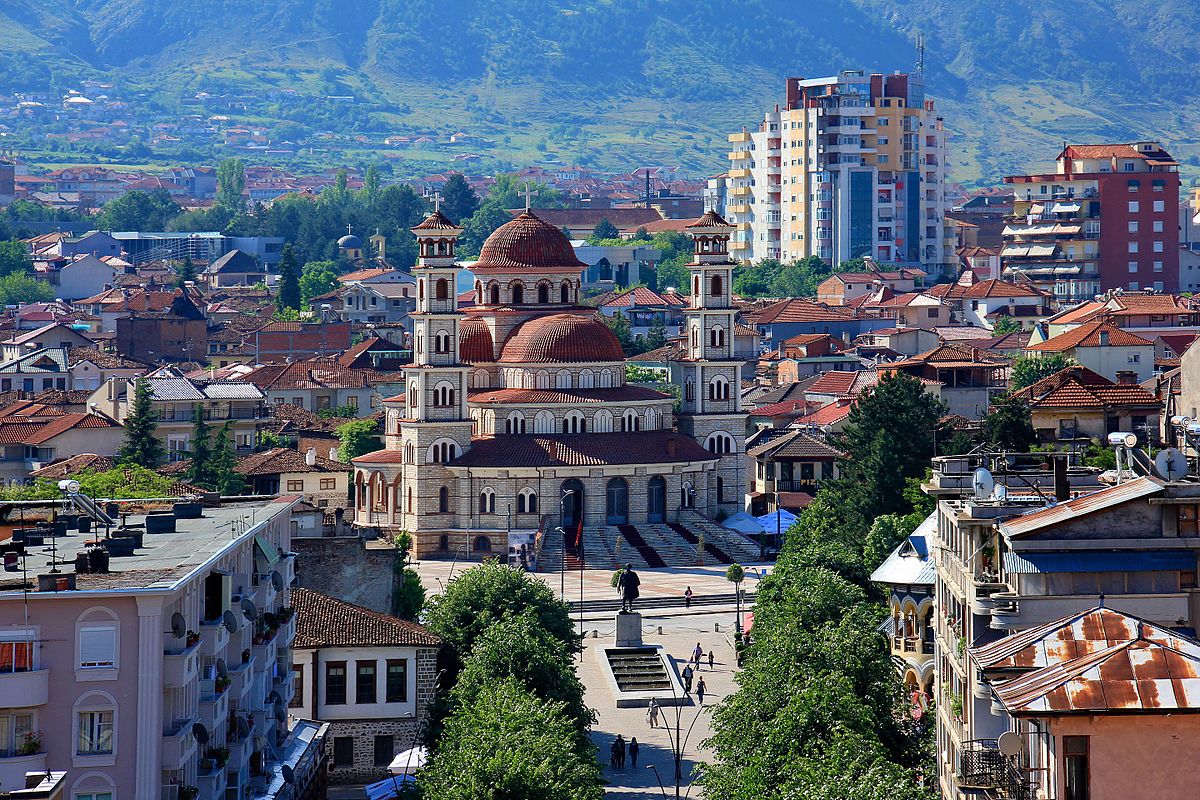
Korca is one of the largest and most important cultural and economic enters of Albania, located in the southeastern part of the country. The city is known for its typical quarters, composed of low houses and villas, which are paved with cobblestone. The city of Korça has a range of museums such as the Education Museum (located in the building where the first Albanian school opened in 1887), the renewed National Museum of Medieval Art (to visit absolutely), the Prehistoric Museum, the House-Museum of the famous landscape painter, Vangjush Mio, the Museum of the Oriental Art “Bratko”, etc. In the vicinity of the city is the cemetery of French soldiers fallen during the First World War.
The Theatre Cajupi is also a place to see concerts or theatre performances depending by the season. Korça is also a very good base for exploring many tourist points located in the nearby mountains such as Voskopoja, Dardha, Vithkuqi and Boboshtica. These villages are well known for offering the possibility to practice many outdoor sports and activities. The area is also famous for the Byzantine churches of Vithkuqi and Voskpoja, whose walls were painted by famous medieval Albanian painters. Close to Korça you can visit Prespa Lake (which is the country’s largest National Park), Drenova National Park, the Illyrian tummulus of Kamenica, etc.
Blue Eye
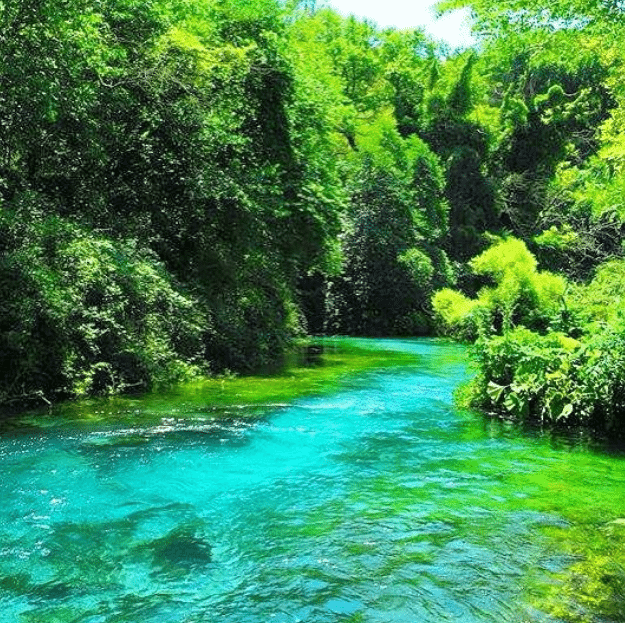
Syri i Kalter (The Blue Eye) is a fairy tale-like spring located in the south of Albania, Delvine district, near the town of Saranda.
A popular tourist attraction, the clear blue water of the river bubbles forth from a stunning, more than fifty-metre-deep pool. Divers have descended to fifty metres, but it is still unclear what the actual depth of the karst hole is.
Not only the spring is the attraction but also the surrounding nature, the forest, and the clearest fresh waters you have seen in your life.
You might have the impression that this place is completely unreal, out of this world, as if specially prepared for a movie set. And, I would recommend that you visit it now, before hordes of tourists find out about it, especially that Albania (although unknown) it’s in the heart of Europe and quite easy to reach.
Valbona Valley National Park

With an area of 8,000 hectares Valbona Valley National Park is the gem of Albanian Alps – Accursed Mountains. Valbona is the name of the river which flows through the Valbona Valley and the village bearing the same name located in the Tropoja District of Northern Albania.
Valbona Valley lies between the rugged and remote and breathtaking mountain peaks and makes a festival of colors and contrasts. Its biodiversity makes it very important as a tourist attraction. The Valbona River is crystal clear and is well known for its clean water, where visitors can swim, catch fishes and do canoeing and kayaking. The Valbona River flows throughout the Valbona Valley to the Drin River.
Valbona village is the focal point of the Valbona National Park. Its configuration, hydrology, forests, flowers, characteristic dwellings and the hospitality of its people, make this park an ideal place to visit and invigorate.
Rocky and dramatically steep high peaks, such as Jezerce, Iron, Kollata (Podi of Kollatës), and Pecmarrës attract hikers, adventurers and mountaineers from all over the world.
Stunning nature, clean air, high and characteristic mountain peaks, lakes, numerous water resources, forests, mountains, flora and fauna of Valbona Valley National Park provide conditions for true eco tourism experiences. There are wonderful well-marked hiking trails that connect the whole area, providing hikers and nature lovers to explore places in Valbona Valley, but also in Plav Lake and Visitor Lake/Mt in Montenegro and further breathtaking trails.
Butrint Archaeological Park
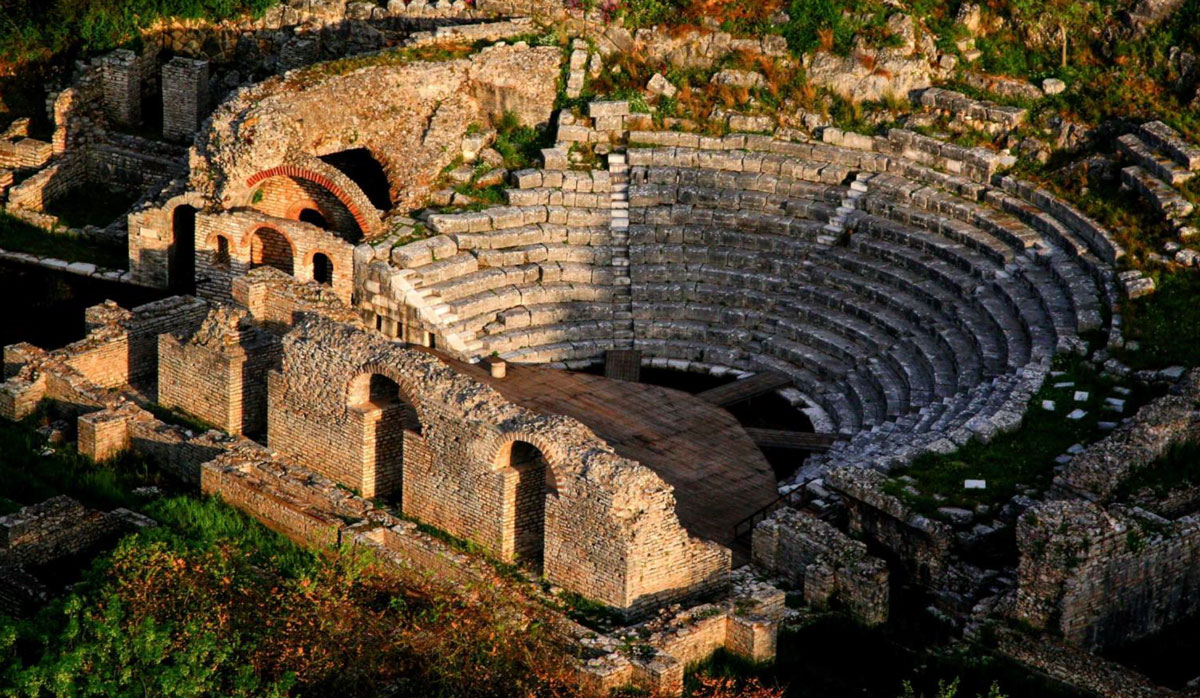
The first Albanian site to be included on UNESCO’s World Heritage was Butrint. Easily the most romantic and beautiful, not to mention largest, of Albania’s ancient sites, Butrint, 18km south of Saranda, is worth travelling a long way to see. The ruins, which are in a fantastic natural setting and are part of a 29-sq-km national park, are from a variety of periods, spanning 2500 years. The most ancient objects found at the archeological site in Butrint are a stone hammer and a shaft belonging to the second half of the second millennium B.C.
Although the site was inhabited long before, Greeks from Corfu settled on the hill in Butrint (Buthrotum) in the 6th century BC. Within a century Butrint had become a fortified trading city with an acropolis. The lower town began to develop in the 3rd century BC, and many large stone buildings had already been built by the time the Romans took over in 167 BC. Butrint’s prosperity continued throughout the Roman period, and the Byzantines made it an ecclesiastical centre.
The city then went into a long decline and was abandoned until 1927, when Italian archaeologists arrived. These days Lord Rothschild’s UK-based Butrint Foundation helps maintain the site.
Location
- “Butrinti” Street, Sarandë
Schedule
- Every day: 09:00 – 19:00
Price
- 700 ALL, Groups of 10 or more: 500 ALL/person
Pogradec

The city of Pogradec was built on the southwestern shores of Lake Ohrid and is one of the most notable cities of Albania for its tradition in hosting “family tourism” and for the pleasant, fresh climate during the summer season.
The road to Pogradec passes along the shore of the tectonic Lake Ohrid, the deepest lake in the Balkans (285 m). This 2-4 million year old lake is under UNESCO protection due to its unique value and is home 17 species of aquatic animals, 70% of which are native and 30% migrant.
The tectonic is the deepest of its kind in the Balkans, reaching a maximum depth of 285 meters. The lake environment is a natural habitat for a variety of old flora and fauna. It houses the rare fish “Koran,” a kind of trout, impossible to find in almost any other lake in the world.
You enter the region of Pogradec via the national highway where the road from Macedonia crosses Qafë Thanë. This crossroad offers picturesque views of Lake Ohrid, a true pearl nestled between Mali i Thatë (the Dry Mountain) to the east and the Mokra highland to the west.
The most visited tourist spots around Lake Ohrid are Lin, Pojskë, Hudenisht and Tushemisht. Worth visiting are the Drilon water sources, located 5 km from Pogradec. Don’t forget about the wonderful restaurants in the area, constructed from wood and offering some of the most delicious dishes of the region.
Ski destination Dardha
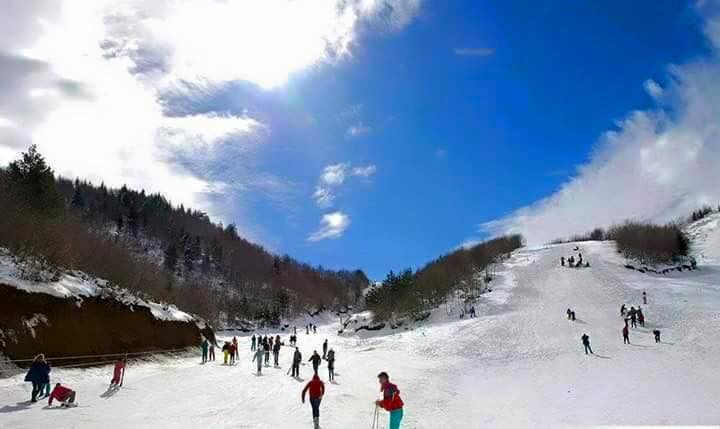
Dardha is a beautiful mountain village located 20 km to the southeast of Korça, tucked between the hills of St. Peter, Autumn Rock, and other hills. This tourist village offers an ideal climate, with rich mountain air providing a refreshing retreat during the whole year. The large snowfall in the winter and ski piste (including one with a lift) are perfect for winter sports, especially skiing.
Dardha (meaning Pear in Albanian) takes its name from the Albanian language expression “The pear fruit falls under the pear tree” , and was founded around 1600.
From the year 1800, Dardha has been known in the region for its woordwork, beautiful traditional clothing, and felt crafts. The village is also known for a special style of axe constructed there, known as the “Dardha Axe”. Dardha is known in particular for its traditional folk clothing and wood work.
Dardha was built with traditional houses of stone walls packed with earth. In the outskirts of the village are newer buildings and a contemporary luxury hotel.
Another characteristic of the city are its rustic cobblestone roads.
A small museum shows the history and heritage of the village.
Another great attraction for tourists are the opportunities for outdoor and nature activities.
Ski slopes (including one piste with a lift) present opportunities for winter sports, especially skiing.
The natural spring waters of Dardha are known throughout the region for the curative properties, especially the sulfur spring. The Sulfur Spring and other natural spring waters are used by locals to treat anemia, stomach problems, kidney problems, and other illnesses.
Lake Koman

May to October is the best season of the year for visiting Koman Lake in Northern Albania, yet June is the best month for taking the boat trip through the lake.
Koman was first created as an artificial lake for one of the three hydropower plants built on Black Drin cascade. It was around 17 years ago that regular ferry boats were used to connect the area with the city of Bajram Curri and further with Gjakova area in Kosovo.
The boat trip lasts approximately three hours while visitors can admire the beauty of the surrounding landscape, small villages that lie on the bank of the lake and several river mouths.
The lake is considered to be one of the most beautiful destinations in Albania. It is highly praised by Albanian and international visitors, especially by those attracted to mountains.
Even though the area lacks some elements, it remains highly attractive to visitors. For the moment, camping, traditional cuisine, and bio foods seem to satisfy all the tourists.
One of the most interesting villages that are great for a camping trip is Berbull. This village is home to several traditional Albanian dwellings known as kulla that watch over the lake. From there it is possible to visit Shala and Daica rivers, two places that are straight out of fairy tales.
Other destinations where to stop while traveling from Koman to Fierza are Berisha and Gomina rivers, Shala and Kaurri caves, the Island of Peace, the Blood Kreek and the villages of Svina, Berbull, Zhub, Berisha, Nanbli, Temal, Toplane, Brise, Salce, Palce, and many others.
Shkoder

Shkodra is one of the oldest cities in the country, founded in the 4th century B.C. as the centre of the Labeat tribe of Illirians known with the name Scodra. Shkodra is very rich in cultural heritage , the city itself as well as the people bear pride in the large number of artists, musicians, painters, photographers, poets, and writers born here. Shkodra’s main tourist attraction is Rozafa Castle. Rising majestically upon a rocky hill west of the city, the outcroppings and battlements paint a blazing picture against the setting sun. It is surrounded by the waters of three rivers; the Drini, Buna, and Kiri. Much like the town it protected, the castle has Illyrian origins. According to the historian Tit Livi, “it was the strongest area of the Labeats.” Like all ancient works, the castle comes with a popular local legend.
Historians tell us a less enchanting and more scientific background of the castle’s characteristics. It reflects the dominion of the Balshaj family but passed through enough other ruling periods that each left their own signs and markings on the grounds, including a distinct Venetian flare, some Ottoman architecture from the 16th and 17th centuries, and even a few modifications from the Bushatllinj family during the 18th and 19th centuries. Shkodra is one of the most important cities of Albania and is also known to be the center of Albanian Catholicism , Culture and Harmony between different religions.
You can visit the renewed Marubi National Museum of Photography famous for its big and rare collection of photos over Albanian history or just take a tour at Pedonalja so called Kole Idromeno street that is the old center of Shkodra , very mediterranean taste passing through mosques and churches. The lake of Shkodra is also suggested to visit , to bath , or to eat some of the best dishes of Albanian cuisine like Krap ne tave typical for this region.
Amphiteatre of Durres

The Amphitheater of Durrës remains one of the most majestic of the ancient world and one of ten most beautiful Roman amphitheaters. Widely recognized among enthusiasts of Antiquity, it is a pearl of the Balkans that is slowly making its way out of the shell. Discovered relatively recently, in 1966, its unearthing occurred in a slightly comical way by Vangjel Toçi.
Built after the 2nd century B.C., this 2700 year-old Amphitheater of Durrës endures as one of the greatest Roman constructions in the region and one of the miracles erected under Roman emperor Trajan.
Made of a structure of bricks and stones, the Amphitheater is composed of a two-story façade decorated with arches and colonnades overlooking the city center.
As with the Roman Coliseum, the equally entertaining and deathly games, represented the moment of culmination for the Amphitheater of Durrës.
Walking under the tunnels in the interior of the Amphitheater will remind you of the scene in “Gladiator,” where Maximus enters the arena amid the chants of the spectators, along with all the emotions that the scene evokes.
The visit, nowadays less dangerous and cheaper than in Antiquity – as the gladiators are long gone and the entrance fee costs only 3 Euros – remains cultural, entertaining and tasty.
Location
The city of Apollo, Apollonia
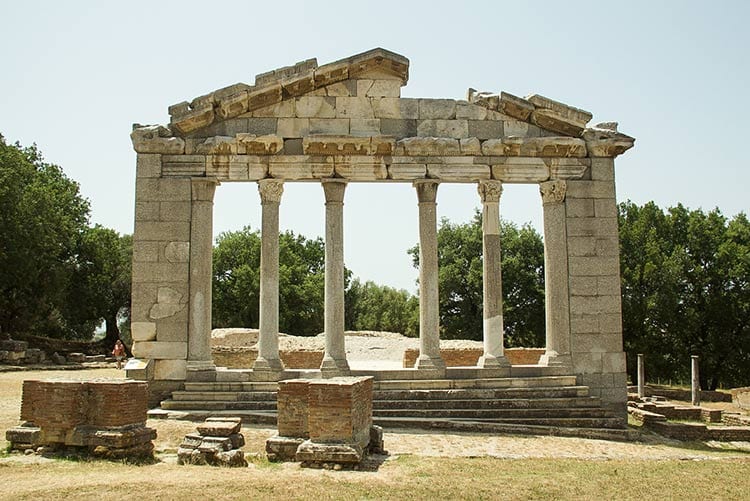
Apollonia, located 11km from Fier near the village of Pojan (Pojani), is one of the most well known archeological sites in the country. It is founded in 588 BC by the Greek colonists coming from Corinth and Corcyra near thye mouth of Vjosa River. Apollonia is one of 30 ancient towns dedicated to God Apollo. The site was already used by Corinthian traders and the Taulantii, an Illyrian tribe, who remained closely involved with the settlement for centuries and lived alongside the Greek colonists.
The fascinating landscape of the archeological park, which has been preserved in an exceptionally intact condition, comprises a successful combination between the beauty of monuments and nature, attractive through its long history, in an atmosphere of relaxation and meditation. While a large part of the ruins remain buried under the ground, what has been excavated within the 4km of city walls is pure poetry. The highlights include the theatre and the elegant pillars of the restored facade of the city’s 2nd-century-AD administrative centre.
While definitely one of Albania’s most important ancient sites, the ruins have fairly minimal descriptions and can be quite hard to piece together, though the on-site Apollonia Museum complex is excellent and does much to make up for the lack of context in the archaeological site itself.
Inside the museum complex is the Byzantine monastery and Church of St Mary, which has gargoyles on the outside pillars and, inside, some faded wall frescoes and impressive Roman floor mosaics.
Apollonia is best visited on a day trip from Tirana or Berat, or as a stop off as you travel down the main road to Albania’s south
Location
- Pojan, Fier
Schedule
- 8am – 6pm Apr – Oct
- 8am – 5pm Nov – Mar
Price
- 400 ALL
Skaderbeg Square

All roads in Tirana lead to Skanderbeg Square (Sheshi Skënderbej), centrepoint of the city and, therefore, the nation as a whole ,arked at its southern end by an equestrian statue of national hero Skanderbeg, who led the ultimately unsuccessful resistance to fifteenth-century Ottoman invasions.
Skanderbeg Square is the best place to start witnessing Tirana’s daily goings-on. Until it was pulled down by an angry mob in 1991, a 10m-high bronze statue of Enver Hoxha stood here, watching over a mainly car-free square. Now only the equestrian statue of Skanderbeg remains, and the ‘square’ – once Tirana’s most popular meeting point in the decades where 99% of people were forced to get around on foot – is now a huge traffic roundabout.
The imposing National History Museum sits at the north side of the square and is worth a quick visit, particularly for its coverage of Hoxha’s concentration camps.
Heading clockwise around the square you’ll find the Palace of Culture, which houses the National Theatre of Opera and Ballet. Then comes the pretty Et’hem Bey Mosque (daily 8am–11pm except during prayer times), which was closed off during Communist rule; one sunny day in 1991, thousands flocked here to make use of their new-found religious freedom. Right next door is the tall clock tower, which can be climbed for views of the square.
Early evening is a particularly nice time to come here. Buskers strum a few tunes and vendors sell popcorn and balloons as the local population strolls and chats.
Location
- Sheshi Skënderbej, Tirana
The memorial grave of Skenderbeg

The Memorial of Skanderbeg is the most monumental tomb in Albania. Though it does not contain the remains of the greatest Albanian hero, George Castriot Skanderbeg, this memorial remains a place of high significance for Lezha and the entire country.
Echoing the grandiose structures devoted to ancient gods, like the Parthenon or the heroic political figures, like the Lincoln Memorial, Skanderbeg’s Memorial is a grand monument supported by marble pillars. Completed in 1981, during Communism, this monument sits atop ruins of an old cathedral. The memorial covers an area of approximately 225 m2 which includes remains of the 14th century St. Nicholas Cathedral. The Cathedral honors the hero’s 25-year war against the Ottoman invaders hence the 25 words and Skanderbeg’s bronze shield that decorate the cathedral’s walls.
Occasional excavations have uncovered ancient walls around the Skanderbeg Memorial, turning this area into a monument of high archaeological value. Many archaeologists speak of underground treasures, including pagan constructions, dating back to the 3rd century A.D.
Location
- “Kuvendi i Arbërit” Street , Lezha District
Schedule
- Every Day: 8:00 – 20:00 April – September
- Every Day: 8:00 – 17:00 October – March
Price
- 100 ALL
Antigonea Archaeological Park

Antigoneia was a very short-lived city, lasting for approximately 150 years. It was founded by one of the most famous names of the ancient world, King Pyrrhus of Epirus (319-272 BC), from whom the phrase “a Pyrrhic victory” derives. At the outset of the 3rd-century BC Pyrrhus was forced to go and fight in Egypt. His abilities impressed Berenice, the wife of King Ptolemy of Egypt, who decided to offer him her daughter, Antigone, in marriage. In token of his gratitude to his mother-in-law and his first wife, Pyrrhus decided to build Antigoneia.
Most impressive are the city walls, demolished by the Romans, which completely encircled the hill. The most visible gate in the walls is at the south-western side of the city. In the city centre an entire street is exposed. The wall section terminates at a small early Christian church of triconch form overlooking the dramatic cliff at this side of the hill. This chapel, built after the city was ransacked by the Romans, has a mosaic floor.
Antigonea is distinguished from other ancient cities through its quadrangular and regular urban plan, similar to many Hellenistic cities of Greece. It indicates also that Antigonea had indeed been created upon decree, and not developed over time.
Location
- Asim Zeneli
Schedule
- Weekdays: 8:00 – 16:00
- Weekends: 9:00 – 15:00
Price
- 200 lek adults
- 100 lek for students and disabled persons
- Free entry on last Sunday of every month except June, July and August